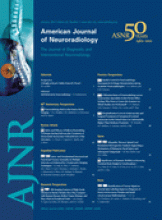Abstract
BACKGROUND AND PURPOSE: DAVFs and small AVMs are difficult to detect on conventional MR imaging/MRA or CTA examinations and often require DSA for definitive diagnosis. The purpose of this study was to assess the value of venous signal intensity on ASL imaging for making this diagnosis.
MATERIALS AND METHODS: Two neuroradiologists and 1 neurologist reviewed MR imaging studies in 26 patients, 15 of whom had DSA-proved DAVFs or small (<2 cm) AVMs. Pseudocontinuous ASL was performed at 1.5T with background-suppressed 3D-FSE readout. Using a 5-point scale, these readers assessed the likelihood of positive findings on a DSA study before and after reviewing the ASL findings. Agreement on imaging findings, including venous ASL signal intensity, was performed by using κ statistics. Logistic regression and ROC analysis were performed to determine which imaging findings improved diagnosis.
RESULTS: Venous ASL signal intensity was seen frequently in cases with positive findings on DSA. The sensitivity and specificity of venous ASL signal intensity for predicting positive findings on a DSA study were 78% and 85%, respectively. On ROC analysis, there was a significant increase in the AUC after review of the ASL images (AUC = 0.798 pre-ASL, AUC = 0.891 post-ASL; P = .02). Multivariate regression identified venous ASL signal intensity as the strongest predictor of positive findings on a DSA study, with an odds ratio of 17.3 (95% CI, 3.3–90.4).
CONCLUSIONS: Identifying venous ASL signal intensity improved detection of DAVFs and small AVMs. Attention to this finding may improve triage to DSA in patients with suspected small vascular malformations.
Abbreviations
- ASL
- arterial spin labeling
- AUC
- area under the ROC curve
- CI
- confidence interval
- DAVF
- dural arteriovenous fistula
- ICH
- intracranial hemorrhage
- pcASL
- pseudocontinuous ASL
- PLD
- postlabeling delay
- ROC
- receiver operating characteristic
- © 2012 by American Journal of Neuroradiology







